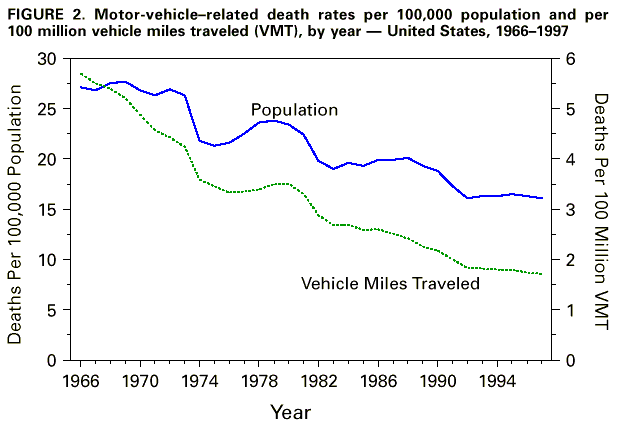Here's an article from 1999 showing the fall in US motor vehicle deaths from the mid-1960s up through the end of the 20th century. US Motor vehicle deaths per million miles travelled fall by about two-thirdd during this time.

Even though this decline in US motor vehicle deaths has continued, it's happening faster in other high income countries. Erin K. Sauber-Schatz, David J. Ederer,; Ann M. Dellinger, and Grant T. Baldwin offers some comparisons in "Vital Signs: Motor Vehicle Injury Prevention — United States and 19 Comparison Countries," which appears in Morbidity and Mortality Weekly Report, July 6, 2016, published by the Centers for Disease Control. They write:
"In 2013, the United States motor vehicle crash death rate of 10.3 per 100,000 population had decreased 31% from the rate in 2000; among the 19 comparison countries, the rate had declined an average of 56% during this time. Among all 20 countries, the United States had the highest rate of crash deaths per 100,000 population (10.3); the highest rate of crash deaths per 10,000 registered vehicles (1.24), and the fifth highest rate of motor vehicle crash deaths per 100 million vehicle miles traveled (1.10). Among countries for which information on national seat belt use was available, the United States ranked 18th out of 20 for front seat use, and 13th out of 18 for rear seat use. Among 19 countries, the United States reported the second highest percentage of motor vehicle crash deaths involving alcohol-impaired driving (31%), and among 15, had the eighth highest percentage of crash deaths that involved speeding (29%). ...As the authors are careful to note, these comparisons are in some sense quick-and-dirty (my phrase, not theirs!). Countries differ in how they collect this kind of data, what the rules are that govern whether a driver is intoxicated, the quality of their roads, other rules they impose about driving (like speed limits) and in other ways. But given that there are a range of possible enforcement policies and ways of investing in safer roads that could plausibly save more than 10,000 American lives per year, surely this is a worthwhile cause for someone to take up?
"If the United States had the same motor vehicle crash death rate as Belgium (the country with the second highest death rate), 12,000 fewer lives would have been lost in 2013 and an estimated $140 million in direct medical costs would have been averted. Similarly, if the United States’ motor vehicle crash death rate was equivalent to the average in the 19 comparison countries, at least 18,000 fewer lives would have been lost and an estimated $210 million in direct medical costs would have been averted."
Something about reducing motor vehicle deaths just isn't politically sexy. It sounds like nagging. One can almost hear the argumentative hypothetical response: "Hey, if I want to drive without a seat-belt and take a risk of killing myself, it's nobody else's business." But friends and loved ones might disagree. Those who die because someone else was driving drunk or texting or on an unsafe road would surely disagree. And we don't get a chance to hear the opinions of those who are already dead.